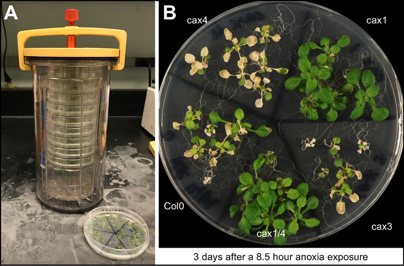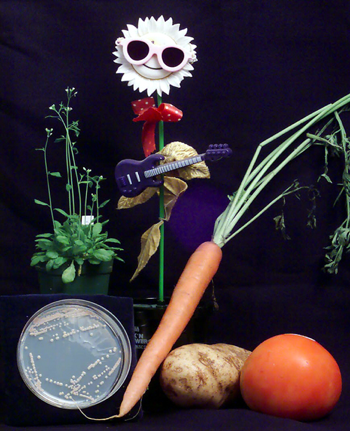Making Plants Grow Better in Difficult Environments

Plants experience a dynamic environment where numerous stress conditions must be mitigated simultaneously. For example, flooding induces the stresses of limited oxygen, changes in temperature, light, osmotic and oxidative conditions. Anoxia is a consequence of waterlogging and submergence of plants. This was seen in Houston in the fall of 2018, when the city received over 50 inches of rain in a three-day period. To ensure survival and limit post-anoxic injury plants must carefully regulate the flow of the little energy produced under stress conditions to essential processes. The transcriptional networks that control gene regulation during oxygen deprivation have been well studied, but the mechanism remain unknown. Our lab has discovered that mutations in the Arabidopsis vacuolar cation/proton exchanger 1 (CAX1) cause dramatic tolerance to anoxic conditions. This robust phenotype was unexpected, and highlights the limitations of transcriptional profiling, because CAX1 gene expression remains unchanged during hypoxia. A series of genetic, imaging and physiological experiments are being undertaken to characterize the role of CAXs in post-anoxic injury. In the future, engineering-impaired CAX expression could circumvent adverse effects of anoxic conditions that impair production agriculture.
Plant Diets and Human Health

A segment of our research focuses on bridging the chasm between plant biology and nutritional sciences. Generations of nutritional scientists have cataloged the nutrients in foods, while in the last several decades plant genome projects have facilitated the development of genetic tools to manipulate nutrient content; however, few studies have assessed the impact that these genetic modifications have on nutrient bioavailability. Our lab contends that bioavailability is determined by the allocation of nutrients within plant cells and that emphasis should be placed on increasing the bioavailable portion of nutrients not simply on increasing the bulk amounts of nutrients in food. To test this we are trying to define the relationship between nutrient partitioning in the plant matrix and nutrient absorption. Initially, we are trying transgenic approaches to systematically repartition various nutrients among isogenic crop lines. Using techniques like synchrotron X-ray Fluorescence (SXRF) microspectroscopy that has been pioneered by my collaborators (T. Punshon-Dartmouth) we can then visualize how genetic and environmental alterations redistribute nutrients inside plant cells. Once we have developed these spatial maps, my group can compare and contrast bioavailability of these nutrients in animal and human feed studies. Our previous findings suggests that simply knowing the nutrient content within plant cells is insufficient. Our long-range goal is to optimize an assortment of technologies to provide a scalable model that can help remedy nutrient deficiencies throughout the world.
Plant Foods and the Microbiome

World-wide, malnutrition contributes to nearly half of all deaths in children under the age of five. For those who survive, malnutrition is part of a cruel cycle of weakened immunity and recurrent infections. Recently, the gut microbiome has been implicated in childhood malnutrition, and cooperative diet-microbe interactions could be important aspects of malnutrition-related deficiencies targeted by therapeutic foods. The World Health Organization recommends that all malnourished children be treated with therapeutic foods; yet the health-promoting components of many foods have not been identified. Plant diets are associated with intestinal health and promoting the development of a diverse and stable microbial system. Plants use exosome-like nanoparticles (ELNs) to communicate to microbes and fungi through the transport of various lipids, proteins and RNAs. This lends to potential impacts on host health through the gut microbiome. Preliminary studies from our group demonstrate that specific gut microbes appear to be ELN competent and this uptake is associated with enhanced bacterial growth. This work will recalibrate the role of therapeutic plant-based diets and their associated ELNs on gut microbiome composition and function.








